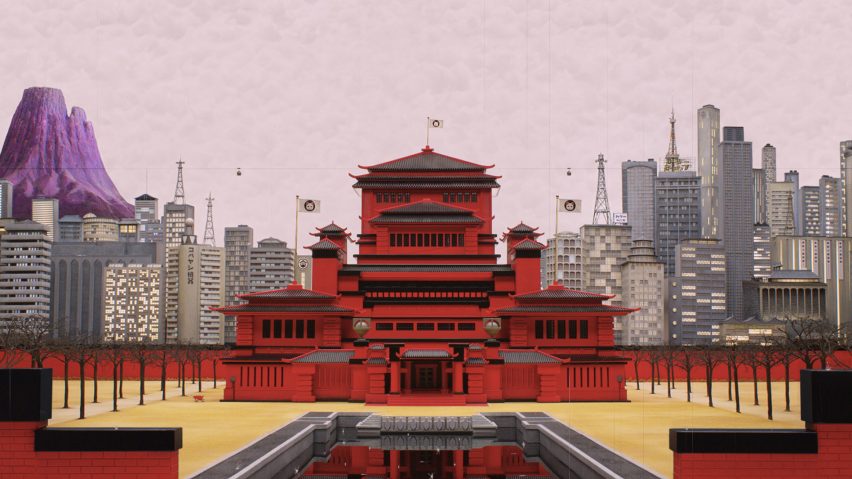The "hellish and beautiful" architecture of Wes Anderson's new film Isle of Dogs takes its cues from the work of Japanese architect Kenzo Tange, says production designer Paul Harrod.
Harrod worked with film director Anderson on the new stop-motion animation, which is about to hit cinemas worldwide. He told Dezeen that he studied Tange, as well as other examples of Japan's future-focused metabolist architecture movement, to create the film's sets.
The film is set in the fictional worlds of Megasaki City and Trash Island, which are located in the Japanese archipelago approximately 20 years in the future.
"The aesthetic was 20 years in the future, but it's not 20 years from our future," Harrod told Dezeen. "It's 20 years from some past point, like if you tried to think of Japan in 1963 and imagine 20 years from that future or past."
"There is something distinctly Japanese about it that feels specific to the place, so we tried as much as possible to make those things that were representing this fictitious version of Japan feel Japanese," Harrod said.
"The metabolists weren't throwing out the history of Japanese design."
Harrod is an animation director and production designer based in Portland, Oregon. He worked with co-production designer Adam Stockhausen to conceive and build the film's 240 sets and 44 stages, which were shot at Three Mills Studios in east London.
The film follows 12-year-old Atari on his quest to find his dog Spots, who has been banished from Megasaki City to Trash Island along with the entire dog population of Japan, following an outbreak of dog flu.
Megasaki City based on metabolist architecture
To visualise Megasaki City, the production designer turned primarily to the architecture of Pritzker Prize-winner Tange. The architect is the most recognised figure in the Japanese metabolism movement, which came about in the 1960s following a period of economic recovery.
"The depiction of Megasaki City is a combination of metabolist and more run-of-the-mill kinds of skyscrapers and buildings," said Harrod.
"Then we combine that in the wide shots of Megasaki City with Old Town, which is essentially a neighbourhood that you see in the foreground of the establishing shot, and which is relatively unchanged in the last 100 years. It's old pre-war Japan in its aesthetic."
Another source of inspiration was the Japanese architecture of Frank Lloyd Wright. Brick Mansion, the home of the villainous mayor of Megasaki, was modelled on the now-demolished Imperial Hotel in Tokyo, designed by Wright in 1923.
"We used the Imperial Hotel as the model for Mayor Kobayashi's residence, the Brick Mansion. We liked how it represented a fusion of traditional Japanese architecture with 20th-century modernism," Harrod told Dezeen.
"While the roof lines suggest an Edo-period design, the structure itself is masonry rather than wood, and the footprint suggests a western-styled plan," he explained.
"I think Frank Lloyd Wright has always been appealing to production designers because of his use of strong horizontal lines and layers are well served by a wide-aspect ratio, but we actually went a bit more vertical with it to give it a more looming presence," he added.
Trash Island references Japan's Edo period
For Trash Island, Harrod referenced traditional ukiyo-e illustrations from the Edo period in Japan, especially the work of artists Hiroshige and Hokusai.
"We would superimpose those two very different things on one another and the idea following from the work that they do – we were aestheticising the trash," he explained.
"The trash is there, your environmental condition, but the way it is depicted has a way of beauty to it. It's both hellish and beautiful at the same time. It's a wasteland. It suffers from incredible industrial pollution."
Harrod and the team used materials like plastic screws and old machine parts to form the environment of Trash Island, which was made to look "gritty" and "distorted".
"We pretty much ran the gambit of model-making techniques there is in this film. You have the contrast between Trash Island, which is very gritty and is a big ruin essentially, with abandoned amusement parks and an animal testing plant which has long been abandoned," explained Harrod.
"Then you contrast that with Megasaki City, which is very bright and clean. The reason for that is that they've decided to take all their waste and dump it on this island. So there's a bit of futuristic element to Megasaki City."
Clouds and toxic fumes were made manually using pieces of cotton wool, while puddles were created using perspex covered in cling film.
"It's a really old technique that has been used in stop motion for years," added Harrod.
"For clouds and toxic fumes and things like that, we work with cotton wool, while Fog can just be a piece of cotton wool placed on the set. The animator physically moves that cotton wool around so it has some life to it, one frame at a time. Usually, the way we would do water is to have a piece of perspex that is covered in cling film and the animators create little wrinkles and bits of bagginess in the cling film that catch the light."
Isle of Dogs is set to be released globally in cinemas from 6 April 2018.

